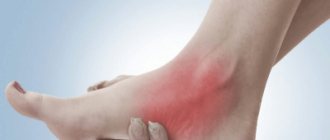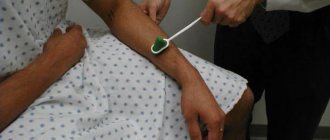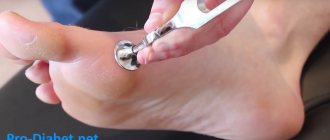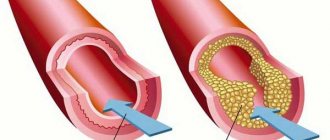Timely diagnosed polyneuropathy of the lower extremities allows for full effective treatment, leading to rapid restoration of leg function. If treatment is not carried out, the neurological disease progresses rapidly and leads to complete immobility and disability.
Proper treatment of polyneuropathy of the lower extremities leads to a rapid restoration of motor activity of all muscle groups and sensitivity of the skin. With prolonged compression and disruption of nerve fiber conduction, it will be very difficult to restore function. Therefore, in case of chronic polyneuropathy of the lower extremities, it is important to consult a neurologist as soon as possible. An experienced doctor will be able to detect the cause of the development of this pathology. After eliminating the action of the pathogenic factor with an effectively developed course of treatment, recovery is achieved after several sessions.
In this article you can learn not only about the symptoms of polyneuropathy of the lower extremities and methods of treatment using manual therapy techniques. It also talks about the main types of neurological disease and the potential causes of its development.
If you require complex treatment for polyneuropathy, we strongly recommend that you make an initial free appointment with a neurologist at our manual therapy clinic. An experienced doctor will conduct an examination, make a diagnosis, and recommend, if necessary, additional examinations. After this, you will be provided with comprehensive information about the possibilities and prospects of treatment.
The main reasons for the development of polyneuropathy
There are many factors that can act as causes of nerve fiber damage. This may be a traumatic effect, compression by a growing tumor, purulent melting of tissue, degenerative and dystrophic processes, metabolic disorders, chemical attack, deficiency of vitamins and minerals, etc. Diabetic and alcoholic polyneuropathy are the most common. They are expressed in the fact that disruption of nerve fiber conduction is associated with toxic damage. In diabetes mellitus, axons are negatively affected by a high level of acetone in the patient’s blood, and in chronic alcohol intoxication, nerve cells are killed by acetaldehyde (methyl formaldehyde), formed in liver cells under the influence of enzymes from incoming ethyl alcohol. This substance is then transformed into acetic acid, which also negatively affects the condition of the nerve fiber.
Other potential causes of polyneuropathy include the following pathogenic factors:
- chronic infection and the presence of foci of bacteria (tuberculosis, syphilis, carious cavities in teeth, chronic pyelonephritis, etc.);
- metabolic disorders (metabolism), including those formed under the influence of regular diets used to reduce body weight;
- nutritional type of obesity and overweight;
- toxic effects of nicotine, carbon monoxide, some salts and heavy metals, alcohol, drugs, poisons and toxins released by bacteria and viruses during their life in the human body;
- use of pharmacological drugs without a doctor’s prescription for a long period of time;
- hereditary predisposition of nerve cells to hypoxic and dysmetabilic processes of destruction;
- impairment of peripheral and central circulation (for example, with compression syndrome or as a result of the development of chronic cardiovascular failure);
- disturbances in the functioning of the immune system, including against the background of chronic infections such as viral hepatitis, HIV, herpes, etc.;
- development of tumor neoplasms in the area of axon passage (usually in this case, polyneuropathy develops in a certain limb);
- deficiency of B vitamins due to an improperly designed diet or their increased consumption (for example, due to disruption of the small intestine);
- lesions of the spinal cord membranes;
- narrowing of the spinal canal;
- infections affecting the peripheral nervous system (tick-borne encephalitis, polio).
Potential risk factors include poor diet, sedentary lifestyle, pregnancy, night work, and the development of degenerative diseases in the spinal column. The effects of compression factors and the consequences of traumatic injury to the spinal column and spinal cord should also be excluded.
Symptoms of diabetic polyneuropathy.
In patients with diabetes, distal sensorimotor polyneuropathy is quite often diagnosed, which first affects the sensory nerves (mostly long ones) going to the hands and feet.
The first symptoms of polyneuropathy usually appear in the feet, but polyneuropathy in the hands takes longer to develop. Over time, small nerve fibers also become involved in the pathological process. Symptoms of damage to small nerve fibers:
- burning or tingling sensation in the arms and legs;
- loss of skin sensitivity to temperature;
- night pain;
- numbness in the limbs;
- feeling of chilliness in the limbs;
- swelling of the feet;
- dryness and flaking of the skin of the extremities;
- increased moisture in feet;
- redness of the skin of the feet;
- the presence of calluses, non-healing wounds and ulcers on the feet.
Symptoms of damage to large nerve fibers:
- increased sensitivity of the skin of the extremities;
- loss of balance;
- pathological changes in joints;
- insensitivity to finger movements.
When sensory nerves are damaged, complete or partial loss of sensation in the limbs begins. A person does not experience pain from cuts, wounds, or burns. As a result, ulcers may occur. If these ulcers become infected, infection and gangrene may occur. In these cases, the only option is to amputate part of the affected limb.
If it happens that the skin on your legs has lost sensitivity, you should urgently consult a doctor. With such a symptom, it is very important to carry out a daily inspection of the feet, and you need to examine not only the sides of the feet, but also the heels, as well as the spaces between the toes. When small nerve fibers are damaged, patients often experience pain in the limbs of various types. They can be aching, dull, tingling, twitching. At night the pain intensifies.
Neuropathy pain sometimes occurs early in diabetes treatment. When blood sugar normalizes, the pain usually disappears, although other symptoms of neuropathy may persist for a longer time. If the sugar remains high and the pain disappears, this indicates the progression of neuropathy. With extensive damage to the sensory nerves, patients may feel coldness in the extremities.
When small fibers are affected, a person may no longer distinguish between cold and hot, which increases the risk of frostbite and burns. However, the most common (and often the only) symptom of polyneuropathy is a feeling of numbness in the limbs. When large nerve fibers are damaged, a person does not feel finger movements or touch.
In addition, balance problems may occur, often described as “not being able to tell where my feet are when I walk.” The most serious difficulties arise when moving in the dark. If the motor nerves are affected, the muscles of the limbs “lose weight” and weaken, but such symptoms do not appear immediately.
Symptoms and signs of polyneuropathy of the lower extremities
The first signs of polyneuropathy of the lower extremities may go unnoticed, since they consist of periodic tingling in different parts of the legs, a feeling of numbness and muscle weakness. All this occurs in paroxysms and quickly passes at an early stage. Gradually, symptoms begin to persist longer. In the acute form of the disease, symptoms of polyneuropathy of the lower extremities may persist permanently. Then the disease passes into the subacute stage of the course, when clinical manifestations become muted and less acute. If treatment is not carried out, chronic polyneuropathy develops, during which periods of exacerbation are replaced by remissions (periods when symptoms may be minor or absent).
The main symptoms of polyneuropathy of the lower extremities may include the following manifestations:
- muscle weakness in the thighs, calves and ankles;
- a feeling of periodic numbness of soft tissues and decreased skin sensitivity;
- a feeling of “cottoniness” in the legs - that they do not obey and cannot be effectively controlled;
- swelling of the ankle joint and lower third of the leg throughout the day;
- tingling in different parts of the legs;
- change in gait in the form of unsteadiness and instability during the development of an attack;
- hyperesthesia and a feeling of goosebumps.
Patients may also experience increased sweating, chilliness, fatigue, decreased performance, lightheadedness, migraine, etc. There are also always clinical symptoms of the underlying pathology against which polyneuropathy develops.
Clinically, the demyelinating and axonal forms of the disease differ significantly. Thus, with the demyelinating form of polyneuropathy, thickening and scar deformation of the nerve fiber occurs. Therefore, among the symptoms, paresis and paralysis of large muscles, weakness of the lower extremities, and the inability to stand independently always come to the fore. And with the axonal form of polyneuropathy, a decrease in skin sensitivity, a change in skin color and a feeling of cold are more often determined.
How to improve blood circulation with neuropathy?
If exercise therapy for neuropathy for the hands or other parts of the body is not effective enough, therapeutic massages should be added to the exercises. This therapy affects soft tissues using special electrical devices or manually. Sunbathing, special oils, as well as simultaneous trips to the bathhouse or sauna are often used here.
The specialist who performs the massage performs smooth movements, causing minimal impact on the patient's skin. Strokes should be directed from the periphery to the central part.
It is also worth considering some caveats, namely:
- since the patient suffers from loss of sensation, the specialist must be careful when applying pressure to the affected parts of the body;
- it is necessary to carefully check the skin, as there is a high risk of injury after a massage;
- If pain occurs during the massage, you should stop immediately and consult a doctor as soon as possible.
Only a highly qualified specialist should engage in such therapy, only in this case the intensity of the symptoms will decrease and the patient will feel a general improvement in his condition. If massage is performed incorrectly, the patient may experience problems with swelling, arthritis, or infections.
For massage to be as effective as possible, the following rules must be followed at home:
- Selection of a place convenient for the patient.
- Monitor your feelings while constantly maintaining a conversation.
- Do not massage in a hurry.
- Use only moderate pressure and smooth movements.
- Before the procedure, you need to prepare special oil, pillows, a blanket and a towel.
- The massage therapist should also take a comfortable position in relation to the patient - standing or sitting.
Diabetic dysmetabolic polyneuropathy of the lower extremities
Dysmetabolic polyneuropathy of the lower extremities develops as a consequence of long-term metabolic disorders. The most common type among this subtype is diabetic polyneuropathy of the lower extremities, in which several pathogenetic factors act:
- disruption of the blood supply to the nerve fiber against the background of a total narrowing of the bloodstream;
- breakdown of proteins and excess glucose to ketone bodies, which are found in large quantities in the circulating blood;
- a change in the functional ability of the muscle fiber that protects the nerves from negative and traumatic influences.
Also, the dismetabolic form of polyneuropathy can occur against the background of gout, ankylosing spondylitis, systemic lupus erythematosus, obesity, hyperfunction of the thyroid gland, etc.
Diagnosis of diabetic polyneuropathy.
The patient is examined by a doctor, collects complaints, and other causes of polyneuropathy are excluded: alcoholism (alcoholic polyneuropathy), tumors and infections of the nervous system, intoxication.
Additionally carried out:
- Checking vibration sensitivity with a tuning fork, temperature sensitivity with water of different temperatures;
- Checking the knee and Achilles reflexes of the lower extremities;
- Electromyography – measurement of muscle potential and contractility;
- Sensory computer testing for diabetic polyneuropathy.
Alcoholic and toxic polyneuropathy of the legs
Chronic alcoholic polyneuropathy of the lower extremities takes a long time to develop. Typically, the first signs appear after several years of regular drinking of strong alcoholic beverages. Currently, fairly young people experience nerve fiber dysfunction due to regular consumption of beer and low-alcohol drinks (cocktails, tuniks, etc.).
Alcohol has a negative effect on the chemical balance of peripheral blood. Also, after drinking such drinks, the liver begins to produce large quantities of acetic acid. It has several types of negative effects on the human body:
- its processing requires a huge amount of various vitamins, including those belonging to group B, as a result of which nerve fiber degeneration develops;
- with the direct effect of acetic acid on the nerve fiber, the breakdown of protein structures occurs, which leads to thickening of the myelin sheath and the development of a demyelinating form of polyneuropathy;
- the compensatory reaction of narrowing of the capillary bloodstream leads to long-term degeneration of the nerve fiber.
With frequent consumption of alcoholic beverages, toxic polyneuropathy of the lower extremities first takes on a subacute and acute form of the course, and then turns into a sluggish chronic process. Ultimately, the patient completely loses his ability to work and becomes disabled.
Possible consequences
If there is a delay in seeing a doctor or lack of treatment, the disease causes irreversible complications, one of which is the transition of the pathology to a chronic incurable form. The patient completely loses the sensitivity of the limbs, the muscles are gradually destroyed, which leads to disability. In severe cases, when the nerve endings responsible for the functioning of the heart muscle are affected, arrhythmia can develop, leading to death.
A favorable prognosis and complete recovery are possible with alcoholic, infectious and toxic types. Diabetic polyneuropathy is incurable, you can only reduce the intensity of symptoms. An infection may also occur, causing septic phenomena and slow healing of wound surfaces.
Neuropathy of the upper and lower extremities is an insidious disease leading to irreversible consequences. At the first incomprehensible manifestations, you should seek medical help. Timely treatment will help avoid serious complications.
Distal axonal polyneuropathy
At the initial stages of the pathological process, distal polyneuropathy of the lower extremities is manifested by the fact that the patient constantly feels cold in the feet. then periodic stabbing pains and a feeling that the leg has served time begin to appear. After a little physical warm-up, all these unpleasant sensations disappear without a trace. However, the attack soon recurs with increasing intensity of clinical symptoms.
Axonal polyneuropathy of the lower extremities, unlike demyelinating polyneuropathy, affects the core of the nerve. The course of the disease is characterized by slow, constant development. If timely treatment is not started, complete immobility quickly sets in.
Sensory, motor and sensorimotor polyneuropathy of the lower extremities
There are five forms of the disease based on the type of functional damage. The first and most common type is motor polyneuropathy of the lower extremities, manifested in the form of cramps of the calf muscles, development of leg weakness, and unsteadiness of gait. If left untreated, the disease spreads quickly, gradually affecting more and more muscle groups from the toes. Leads to complete immobility of the lower extremities.
With sensory polyneuropathy of the lower extremities, motor function disorders may be absent. However, burning and stabbing pain, impaired skin sensitivity, the appearance of areas of paresthesia, etc. come to the fore.
Sensorimotor polyneuropathy of the lower extremities is a simultaneous violation of the motor and sensory activity of the nerve fiber. A person gradually loses the sensitivity of the skin of the lower extremities and, in parallel, develops muscle weakness, lameness, and the inability to make habitual movements with his legs.
The vegetative form is reflexive and includes a symptom complex reflecting malfunctions in the functioning of internal organs and the autonomic nervous system. Typically, secondary vegetative-vascular dystonia is observed in young people against the background of toxic polyneuropathy. Against the background of this type of nerve fiber damage, bladder dysfunction may occur (hyperactivity, urinary incontinence, lack of urination, etc.). In men, autonomic polyneuropathy often leads to the development of erectile dysfunction and complete impotence.
Mixed polyneuropathy may also develop, the clinical picture of which will reflect sensorimotor and autonomic disorders in the human body. This is the most severe type of the disease.
Treatment of polyneuropathy of the lower extremities
It is necessary to begin treatment of polyneuropathy of the lower extremities by eliminating the potential cause. If it is diabetes, then it is important to monitor and regulate blood sugar levels. If the cause is the influence of alcohol, then you need to stop taking it completely.
After eliminating the cause, it is important to carry out a course of restorative treatment. To restore the function of the nerve fiber, it is important to restore its physiological structure. The easiest way to do this is through reflexology. A targeted effect on biologically active points triggers the process of tissue regeneration. Osteopathy allows you to restore capillary blood supply and drainage of lymphatic fluid.
Therapeutic gymnastics and kinesiotherapy allow you to start the process of restoring normal innervation of the tissues of the lower extremities. In order for the therapy to be effective and not take a lot of time, it is necessary to contact a neurologist as early as possible.
In our manual therapy clinic, a neurologist provides free consultations. The right to receive a free initial consultation with a neurologist is granted to each patient. During the appointment, an examination will be carried out, a diagnosis will be made and information will be provided on how to effectively treat and restore the function of the lower extremities for various forms of polyneuropathy.
The simplest exercises
Research shows that strengthening exercises for peripheral neuropathy moderately improve muscle tissue, relieve neuropathic pain, and help control blood sugar.
Therapeutic physical activity includes the following exercises:
- aerobic;
- to maintain balance;
- power;
- for flexibility.
The approximate duration of classes is about 30 minutes a day - 3-5 times a week. You can start with 5 or 10 minutes a day and gradually increase your exercise time, or divide the activity throughout the day by taking a 10-minute walk after each meal.
Warming up for 5 to 10 minutes helps warm up and prepare the body for aerobic activity.
- Aerobic exercise . Such workouts are very varied and can include: walking in the fresh air, exercise on an exercise bike or treadmill with low loads. Classes in the pool including aerobic exercises in the water.
- Balance exercise . Example exercise: stand directly behind a chair, holding onto it with your hands and legs slightly apart. Holding onto a chair for balance, slowly raise one leg to the side 20-40 centimeters and hold it for 5-10 seconds. Slowly lower your leg and repeat the exercise on the other leg. Your back and knees should be straight throughout the entire workout. Do 2 repetitions on each leg twice a day.
- Strength exercise . An accessible exercise for which you need to use a stable chair with armrests: legs are separated, one leg is in a tucked position under the front of the chair, the other leg is placed comfortably in front and slightly to the side. Slowly shift your weight forward until your legs begin to support your body weight. Slowly tense your legs, moving to a standing position. Lower yourself onto the chair slowly, reaching towards it with your hips. Do not “plop down” on a chair and do not rest between repetitions. Repeat: 10 -15 times. Do an exercise for the second leg. Do 2 repetitions twice a day
- Flexibility exercises (stretching) can help keep joints flexible and reduce the likelihood of injury during other activities. Flexibility exercise: In a standing position, place one leg far behind, with the toe slightly inward. Take a big step forward with your opposite foot. With your front knee slightly bent, lean forward, keeping your heels on the floor. You should feel a muscle stretch in your calf and back leg. Hold the position for 15-20 seconds for each leg. Repeat the exercises twice a day.
Exercise therapy for leg neuropathy
Any exercise increases the heart rate, develops muscles and increases the breathing rate. You must first obtain a doctor's prescription before starting any exercise program.











